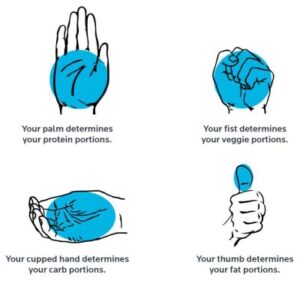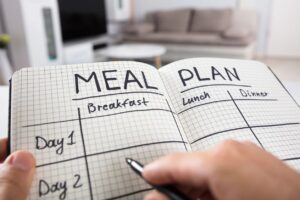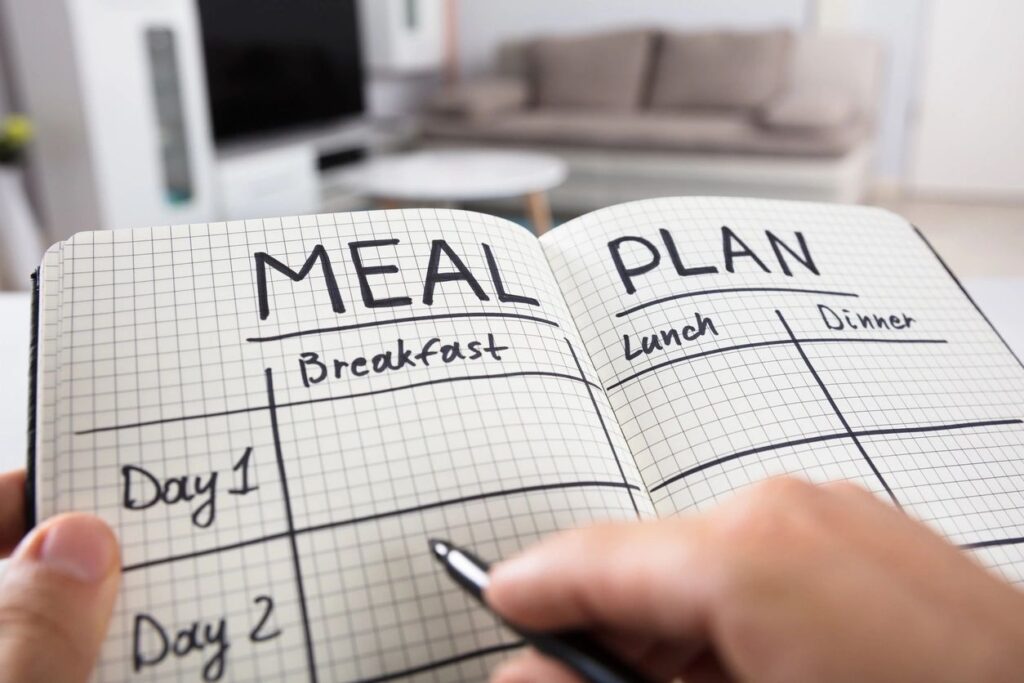I don’t use recipes or meal plans. Here’s why.
 As a strength and nutrition coach, I often get requests for “healthy recipes” from friends, family, training clients, and random strangers who find out what I do for a living.
As a strength and nutrition coach, I often get requests for “healthy recipes” from friends, family, training clients, and random strangers who find out what I do for a living.
But you know what? I don’t do recipes. At least, I very rarely use them to try new dishes. But the majority of my cooking is pretty basic and doesn’t involve any recipes.
I find following recipes time-consuming and costly. First, you have to shop for special ingredients you wouldn’t normally stock in your kitchen. The price for each and every novel ingredient adds up, and you’re not likely to re-use many of those ingredients unless you make the dish again. Secondly, once you have all your special ingredients, you have to read the recipe to make sure you know how to follow it, which takes time. Then following the recipe itself takes even more time since you’re likely unfamiliar with how to prepare this new dish.
All of that hassle is only part of the reason I don’t follow recipes.
Many recipes make it harder to track your calories and macros. If you’re trying to lose weight or build muscle, tracking what you eat is super important (read more here).
Recipes make tracking harder than it has to be because once you’ve mixed everything together, it’s pretty tough to tell how much of each ingredient makes it onto your plate. You could always input all of the ingredients you used to make the dish into your food app, divide the dish evenly into “x” number of servings, and take the average of the macros… but ain’t nobody got the time to play Rain Man before dinner.
Instead of spending time hunting down “healthy recipes” on the Internet, I spend time in the kitchen meal prepping.
I know that’s something of a buzz word these days, so allow me to clarify. “Meal prep” simply means to prepare food for meals ahead of time. This could be as simple as slicing veggies for salads or snacks, or as complicated as the brightly colored Tupperware you can find searching Pinterest for meal prep ideas. It’s important to realize that meal prep needn’t be as complicated or time-consuming as Pinterest makes it look.
A simple method for making meal prep as painless as ordering from DoorDash is called the “3-3-3” method. Pick three proteins, three starches, and three vegetables. Cook them. You’re done.
Putting The 3-3-3 Method To Work
My three proteins are eggs, chicken, and salmon. I hard boil the eggs, throw the chicken in the crockpot with chicken stock and some spices, and season the salmon before baking it at 300* for 10-15 minutes (cooking time varies depending on the size and thickness of the fillets).
My three starches are rolled oats, sweet potato, and minute rice. The sweet potatoes go in the oven along with the salmon, but obviously stay in for longer than 15 minutes (usually 40-45, depending on the size of the potatoes). I cook the minute rice and oats on an as-needed basis since they take only a few minutes, but you could easily use a rice cooker, crockpot, Instant pot, or stove top to cook a large batch ahead of time and portion out individual servings into containers.
My three veggies are mixed greens, broccoli, and oven-roasted carrots. Peel the carrots, toss lightly with olive oil or melted butter, and coat with salt and pepper. When the salmon comes out of the oven, the carrots go in and stay until they’re cooked through (usually around the time the sweet potatoes are done, about 20 minutes). In the meantime, throw the broccoli in a pot of boiling water for about 10-12 minutes until al dente. The mixed greens will be eaten raw, so no prep required.
Putting Together My Menu
- Breakfast: oats + eggs + berries (not a veggie, but stick with me)
- Lunch 1: Chicken on mixed greens + olive oil dressing
- Lunch 2: Chicken + sweet potato + broccoli
- Dinner: Salmon + rice + broccoli + carrots
 Those are just a few possible combinations. Use your imagination to mix and match the 3-3-3 foods you prepared. It’s helpful to think about using different herbs, spices, and low-calorie sauces to change up the flavors and prevent boredom with the same foods.
Those are just a few possible combinations. Use your imagination to mix and match the 3-3-3 foods you prepared. It’s helpful to think about using different herbs, spices, and low-calorie sauces to change up the flavors and prevent boredom with the same foods.
Pro tip: It’s best to measure out your portions (using measuring cups and a food scale, like this one), but you can use your hands to estimate appropriate portions, too.
Other Easy 3-3-3 Options…
- Protein: grilled or baked chicken, lean “loin” cuts of beef or pork, lean ground meat, thick-sliced ham, deli meat, cottage cheese, yogurt, and soy/seitan if you swing that way
- Starch: oats, rice, quinoa, beans, potatoes, egg noodles, rice noodles, whole grain breads and wraps, starchy fruits like bananas, and starchy veggies like squashes
- Vegetables: leafy greens, green beans, broccoli, asparagus, brussels sprouts, mushrooms, peppers, carrots, cucumber, tomato, etc
Convenience Foods
You can round out the week with ready-to-go snacks like single-serve Greek yogurt with fruit and/or granola, single-serve hummus and cut veggies, apples, bananas, string cheese, jerky, and the occasional protein bar (I like Rx Bar and Larabars).
 What About Meal Plans?
What About Meal Plans?
“Can’t you just tell me what to eat?” Nope.
Put simply, I don’t use or give out meal plans because people don’t follow them. Life happens, and when you can’t follow the meal plan as written… then what?
Much better to learn to feed yourself in all possible situations so you can, you know, hit your goals while still enjoying your life.
The Bottom Line
Recipes are great for learning a new dish, cooking style, or impressing friends and family.
But you don’t need recipes or a meal plan to eat healthy. You just need to prepare some things ahead of time so that you have healthy, pre-cooked foods on hand when you’re hungry.
Stop putting so much pressure on yourself to be a gourmet chef and invest the time to learn basic cooking skills.
Hand Portion Photo Credit: Precision Nutrition

